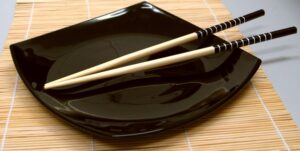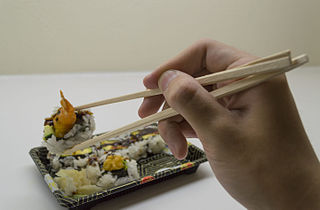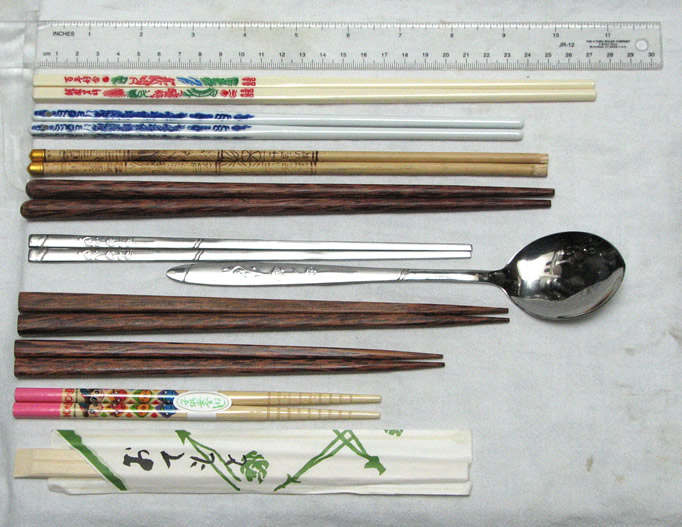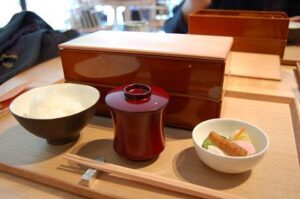
Did you know February 6 is National Chopstick Day? It’s an obscure commemoration for unique eating utensils used by about one-third of the world’s population. Chopstick use requires a surprising amount of dexterity, and involves 30 joints and 50 muscles in the right-hand fingers, wrist, arm, and shoulder. In other words, using chopsticks is harder than it looks.

Place the first chopstick in your right hand between the index finger and thumb, and balance it against your ring finger. Place the second chopstick the same way, but rest it on your middle finger instead of the ring finger. The bottom chopstick remains stationary while the index and middle fingers work the upper chopstick up and down. Be patient until you get the hang of it. And remember, if small children can learn how to use chopsticks, so can you.
When did people start using chopsticks & why?
Chopstick history is a story of ingenuity and adaptation. The word chopstick may be derived from Chinese Pidgin English. The term chop-chop meant quickly. So chopstick might translate to “quick-sticks.” The Chinese word for chopsticks, kuaizi, translates as ‘quick little bamboo fellow.’ Neither explanation connects chopsticks directly with food.
The earliest archeological evidence of chopstick use is from tombs found at Yin in Henan province. The bronze implements date from 1200 BCE, and mostly likely were used to reach into boiling water or oil while cooking. Wooden twigs probably predated chopsticks. But these chopsticks were about stirring pots and moving wood under the cooking fire.
The first eating utensil was probably a spoon, partly because millet was the dominant grain. Millet is best consumed in the form of porridge or gruel.

People began eating with chopsticks about 400 CE. Population growth forced cooks to develop cost-saving measures. One change was chopping food into smaller pieces that could cook quickly and use less fuel. The smaller pieces were a perfect fit with chopsticks.
The change in dominant grains from millet to wheat and rice further encouraged the use of chopsticks.
Knives, which may have once joined spoons on the table, weren’t needed any more. Confucius advised that “The honorable and upright man keeps well away from both the slaughterhouse and the kitchen. And he allows no knives on his table.” In keeping with this spirit, Chinese chopsticks have blunt, rather than pointed, ends.
As Chinese culture spread throughout Asia, so did the use of chopsticks. Each culture adapted chopsticks for their own use.

From top to bottom, this picture illustrates plastic chopsticks from Taiwan, porcelain chopsticks from Mainland China, bamboo chopsticks from Tibet, palm wood chopsticks from Indonesia, stainless steel flat chopsticks with matching spoon from South Korea, two sets of Japanese chopsticks, Japanese chopsticks for children, and disposable chopsticks.

Japanese refer to chopsticks as Hashi, or bridge. Japanese chopsticks are shorter than Chinese, partly because Japanese diners bring food containers, particularly bowls, closer to their mouths. Men’s chopsticks are 8 inches long; women’s, a mere 7 inches. In 1878 Japan developed disposable chopsticks, called waribashi.
Korean chopsticks are unique, because they’re made from metal. Korean rulers worried their food might be poisoned and ate with silver chopsticks, because they thought it would corrode or turn black if the metal touched anything poisonous. Common people imitated the custom with chopsticks made from other metals. Now, most chopsticks in Korea are made from stainless steel, because it’s easier to clean to a high level of hygiene.
Chopsticks can be made from almost any firm material, most often bamboo or wood, but also ivory, jade, coral, brass, silver, or steel. Disposable chopsticks are probably the most common.

In 2011 the New York Times reported that about 3.8 million trees are needed to manufacture 57 billion disposable pairs of chopsticks in China. Cotton wood, birch, and spruce trees provide raw material for 45 percent of these, with the remainder produced from bamboo. A 2013 report in the South China Morning Post placed the production figure at 80 billion pairs of disposable chopsticks, at an annual cost of 20 million trees.
About half the disposable chopsticks produced in China stay in China, with the other half going to export. Seventy-seven percent of exports go to Japan; 2 percent to South Korea, and 2 percent to the U.S.
According to a 2008 United Nations report, 10,800 miles of Asian forests disappear each year. Production of disposable chopsticks is responsible for a significant amount of this deforestation.

Activists are trying to reduce production of disposable chopsticks by campaigns encouraging people to bring their own chopsticks to restaurants.
🥢🥢🥢
Chopsticks in use by Takashi Mukoda.
Cooking in Hot Pot by Jason M. C., Han
Many Chopsticks by Five Rings at English Wikipedia.
Rice, miso soup, tsukemono, and chopsticks by Sunday driver in Kyoto
Disposable Wooden Chopsticks on Kappabashi-dori street in Asakusa, Tokyo by Steven-L-Johnson.
Myhashi portable chopsticks by Blue Lotus.
“How to Use Chopsticks.” The Woks of Life.
Stephanie Butler. “A Brief History of Chopsticks.” History. Aug. 22, 2018.
Emily Kuo. “Think Before You Use.” Expedition PR. July 11, 2013.
Chris Luo. “China’s 80 billion disposable chopsticks a ‘burden’ on forests.” South China Morning Post. Mar. 11, 2013.
Rachel Nuwer. “Disposable Chopsticks Strip Asian Forests.” New York Times. Oct. 24, 2011.

Sandra Wagner-Wright holds the doctoral degree in history and taught women’s and global history at the University of Hawai`i. Sandra travels for her research, most recently to Salem, Massachusetts, the setting of her new Salem Stories series. She also enjoys traveling for new experiences. Recent trips include Antarctica and a river cruise on the Rhine from Amsterdam to Basel.
Sandra particularly likes writing about strong women who make a difference. She lives in Hilo, Hawai`i with her family and writes a blog relating to history, travel, and the idiosyncrasies of life.

